Actin cables and comet tails organize mitochondrial networks in mitosis
- PMID: 33658713
- PMCID: PMC7990722
- DOI: 10.1038/s41586-021-03309-5
Actin cables and comet tails organize mitochondrial networks in mitosis
Abstract
Symmetric cell division requires the even partitioning of genetic information and cytoplasmic contents between daughter cells. Whereas the mechanisms coordinating the segregation of the genome are well known, the processes that ensure organelle segregation between daughter cells remain less well understood1. Here we identify multiple actin assemblies with distinct but complementary roles in mitochondrial organization and inheritance in mitosis. First, we find a dense meshwork of subcortical actin cables assembled throughout the mitotic cytoplasm. This network scaffolds the endoplasmic reticulum and organizes three-dimensional mitochondrial positioning to ensure the equal segregation of mitochondrial mass at cytokinesis. Second, we identify a dynamic wave of actin filaments reversibly assembling on the surface of mitochondria during mitosis. Mitochondria sampled by this wave are enveloped within actin clouds that can spontaneously break symmetry to form elongated comet tails. Mitochondrial comet tails promote randomly directed bursts of movement that shuffle mitochondrial position within the mother cell to randomize inheritance of healthy and damaged mitochondria between daughter cells. Thus, parallel mechanisms mediated by the actin cytoskeleton ensure both equal and random inheritance of mitochondria in symmetrically dividing cells.
Figures

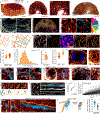

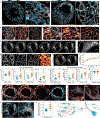
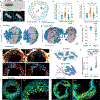
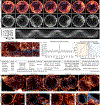
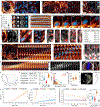
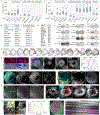

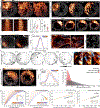



Comment in
-
Actin(g) in mitochondria inheritance.Nat Rev Mol Cell Biol. 2021 May;22(5):303. doi: 10.1038/s41580-021-00360-y. Nat Rev Mol Cell Biol. 2021. PMID: 33723436 No abstract available.
-
Stir it up: The role of actin in mitochondrial mixing during mitosis.Dev Cell. 2021 Apr 19;56(8):1080-1082. doi: 10.1016/j.devcel.2021.03.028. Dev Cell. 2021. PMID: 33878298
Similar articles
-
Mitochondrial manoeuvres: latest insights and hypotheses on mitochondrial partitioning during mitosis in Saccharomyces cerevisiae.Bioessays. 2010 Dec;32(12):1040-9. doi: 10.1002/bies.201000083. Epub 2010 Sep 30. Bioessays. 2010. PMID: 20886527 Review.
-
Myo19 ensures symmetric partitioning of mitochondria and coupling of mitochondrial segregation to cell division.Curr Biol. 2014 Nov 3;24(21):2598-605. doi: 10.1016/j.cub.2014.09.045. Epub 2014 Oct 23. Curr Biol. 2014. PMID: 25447992 Free PMC article.
-
Mitochondrially-associated actin waves maintain organelle homeostasis and equitable inheritance.Curr Opin Cell Biol. 2024 Jun;88:102364. doi: 10.1016/j.ceb.2024.102364. Epub 2024 Apr 30. Curr Opin Cell Biol. 2024. PMID: 38692079 Review.
-
Live cell imaging of mitochondrial movement along actin cables in budding yeast.Curr Biol. 2004 Nov 23;14(22):1996-2004. doi: 10.1016/j.cub.2004.11.004. Curr Biol. 2004. PMID: 15556861
-
Stir it up: The role of actin in mitochondrial mixing during mitosis.Dev Cell. 2021 Apr 19;56(8):1080-1082. doi: 10.1016/j.devcel.2021.03.028. Dev Cell. 2021. PMID: 33878298
Cited by
-
Competition and synergy of Arp2/3 and formins in nucleating actin waves.Cell Rep. 2024 Jul 23;43(7):114423. doi: 10.1016/j.celrep.2024.114423. Epub 2024 Jul 4. Cell Rep. 2024. PMID: 38968072 Free PMC article.
-
The Multifaceted Regulation of Mitochondrial Dynamics During Mitosis.Front Cell Dev Biol. 2021 Nov 3;9:767221. doi: 10.3389/fcell.2021.767221. eCollection 2021. Front Cell Dev Biol. 2021. PMID: 34805174 Free PMC article. Review.
-
Nucleation, stabilization, and disassembly of branched actin networks.Trends Cell Biol. 2022 May;32(5):421-432. doi: 10.1016/j.tcb.2021.10.006. Epub 2021 Nov 23. Trends Cell Biol. 2022. PMID: 34836783 Free PMC article. Review.
-
Regeneration of actin filament branches from the same Arp2/3 complex.Sci Adv. 2024 Jan 26;10(4):eadj7681. doi: 10.1126/sciadv.adj7681. Epub 2024 Jan 26. Sci Adv. 2024. PMID: 38277459 Free PMC article.
-
Mitochondria transplantation between living cells.PLoS Biol. 2022 Mar 23;20(3):e3001576. doi: 10.1371/journal.pbio.3001576. eCollection 2022 Mar. PLoS Biol. 2022. PMID: 35320264 Free PMC article.
References
-
- Carlton JG, Jones H & Eggert US Membrane and organelle dynamics during cell division. Nat Rev Mol Cell Bio 21, 151–166 (2020). - PubMed
-
- Taguchi N, Ishihara N, Jofuku A, Oka T & Mihara K. Mitotic Phosphorylation of Dynamin-related GTPase Drp1 Participates in Mitochondrial Fission. Journal of Biological Chemistry 282, 11521–11529 (2007). - PubMed
Additional references:
-
- Simpson CL, Kojima S & Getsios S. RNA interference in keratinocytes and an organotypic model of human epidermis. Methods in molecular biology (Clifton, N.J.) 585, 127–46 (2010). - PubMed
Publication types
MeSH terms
Substances
Grants and funding
LinkOut - more resources
Full Text Sources
Other Literature Sources
Research Materials
Miscellaneous

